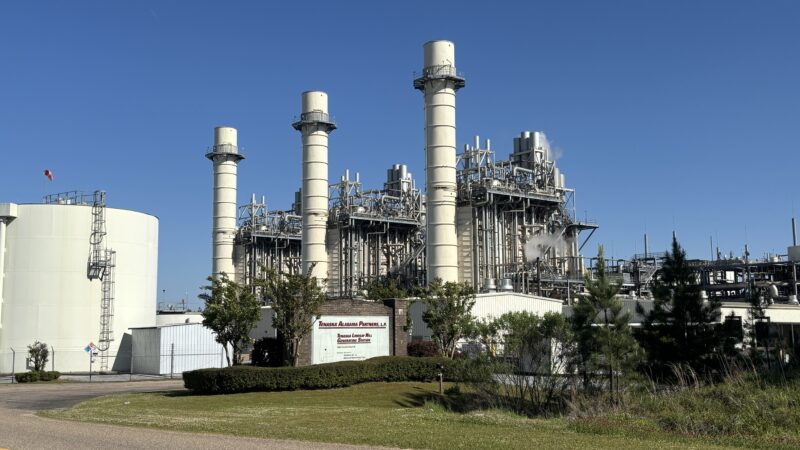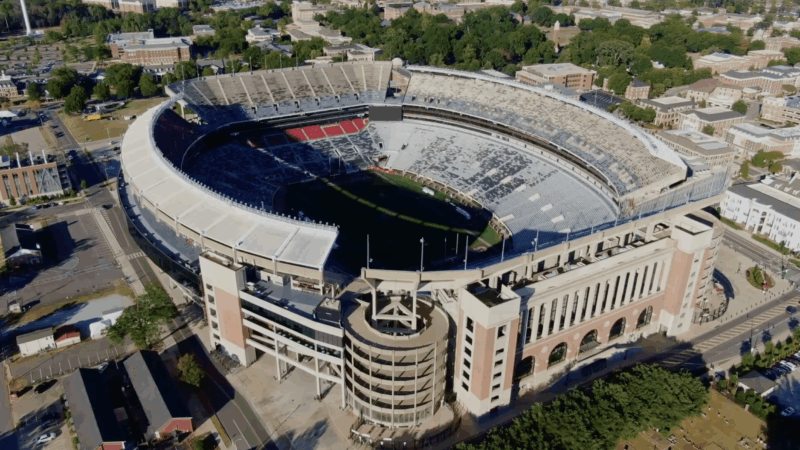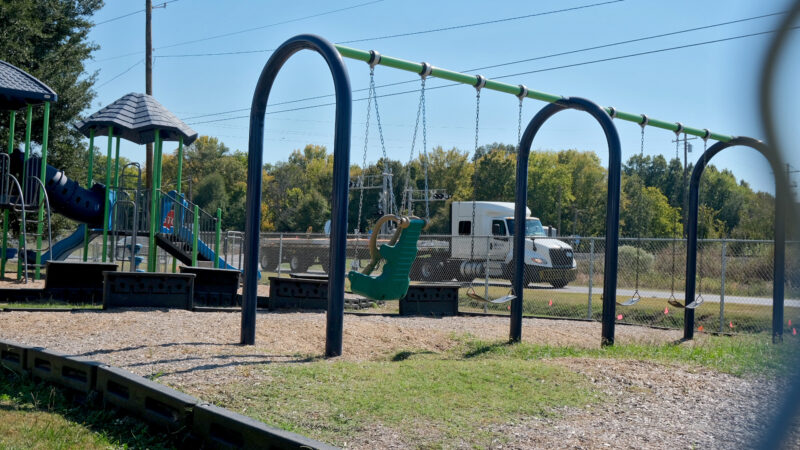A cell pulls off one of the ‘Holy Grails’ of biotechnology
A group of researchers has won a large science prize for a discovery not quite two decades in the making.
It was long thought that only simple microbes had mastered a chemical conversion reaction that helps create some of the essential building blocks of life. But scientists have found that a more complex organism — a single-celled alga with a nucleus — can do it, too, thanks to a newly identified piece of cellular architecture. They’re calling it the nitroplast.
One day, the nitroplast may revolutionize farming. “It’s one of the Holy Grails of biotechnology,” says Jon Zehr, a now-retired microbial ecologist from UC Santa Cruz — the ability to engineer plants that could snatch nitrogen out of the air and use it to grow without any of the pollution, energy, or expense that current fertilizers require.
This is the story of how a group of international scientists solved a remarkable microscopic riddle.

A mysterious shred of DNA
Starting in the late 1990s, Zehr was confronted with a puzzle. On research cruises, while testing sea water, he and his colleagues kept finding the same fragment of DNA in the ocean. When they went to look for the organism it came from, however, no one ever managed to see it.
“Every time we would get these samples,” says Zehr, “we would look through the microscope and there’s nothing there.” And yet, the DNA was everywhere — in the open ocean, along the coast, in the tropics, and the Arctic. “We were chasing this organism from a piece of DNA for a long time.”
The DNA also appeared to have a special and rare function — of taking nitrogen gas from the surroundings, which living things need to survive, and turning it into a form that could then be fashioned into proteins and DNA.
Usable nitrogen like this is pretty scarce in the environment. “That’s why we add it as fertilizer in agriculture,” says Zehr. “The same is true in the oceans. It’s in short supply over wide regions of the ocean.”
One of the first clues to this puzzle was realizing that whatever had produced this fragment of DNA was missing all sorts of essential genes. There was something incomplete about it. “It had all of these holes or gaps,” says Zehr. (These gaps included the genes responsible for what lights up under the microscope, hence rendering it invisible to Zehr and his colleagues.)
To survive, he figured it had to be getting help from another life form, “which would explain how it could be missing so many genes because it lives with somebody else who can provide those things,” he says.
Zehr was right. That somebody else turned out to be a kind of single-celled algae called Braarudosphaera bigelowii, which looks like a teensy soccer ball.
Tiptoeing nearer
Further experiments required growing the soccer ball-looking algae in the lab, along with its mysterious little friend. This was a mighty challenge. The cells kept dying. Paleontologist Kyoko Hagino of Kochi University tried for twelve years until she finally cracked it with a cousin of the original organism. “They were swimming very nicely,” she says, “so I was very excited.”
This big breakthrough allowed the team to partner with the Lawrence Berkeley National Laboratory to use X-rays generated by a particle accelerator to peer inside that soccer ball. “It’s much like doing a medical CT scan where you can see inside of the cell non-destructively, so you don’t have to cut the cell open,” says Carolyn Larabell, a cell biologist at UC San Francisco.
Structural biologist Valentina Loconte was struck by what she saw. “Inside the alga I found a little cell,” she says. “We couldn’t see any of the original alga that didn’t have a little cell inside.”
This little entity — what appeared at the time to be a little cell — was the oddball source of all that mysterious DNA in the ocean. “It means that the two organisms are really living together,” says Loconte.
And when she then looked at how the two apparent cells — the little one inside the big one — divided, they were synchronized. This raised a tantalizing possibility: What if the little entity wasn’t its own being at all? What if it was part of the bigger algal cell?
So Tyler Coale, a phytoplankton biologist at UC Santa Cruz, pored over the inner workings of both by analyzing their proteins. He soon realized the two needed one another. He found the little guy’s missing genes were housed in the big cell. And the big cell received nitrogen from the little guy. This nitrogen conversion ability is a “kind of an extra superpower,” says Kendra Turk-Kubo, a microbial oceanographer at UC Santa Cruz. “That’s a really important part of this relationship.”
“And at that point,” says Coale, “it makes it very difficult to call these two different organisms if their genomes are so intermingled.”
Instead, he and his colleagues argued, this was a single organism. The little guy was actually the nitroplast — a component of the bigger algal cell.
When two became one
Until this discovery, the ability to transform nitrogen from a gas into a usable form — something called nitrogen fixation — was a feat that scientists thought only certain kinds of bacteria and other simple microbes could pull off.
But that view has now changed thanks to this work. Some 140 million years ago, a free-living bacteria that could grab all the nitrogen it wanted out of the water it was swimming in fused with an ancient algal cell.
“One cell engulfs another,” says Coale, “and then doesn’t digest it, but rather incorporates it into its own body.”
Over time, the bacteria jettisoned some of its genes, the algae became dependent on the nitrogen it was receiving — until eventually, each one could no longer live without the other. The two came to rely on one another deeply, “the process of two species becoming one,” Coale says.
This process “has been pivotal in the evolution of complex life on Earth,” he says. By that, Coale means it’s a lot like what gave rise to the mitochondria (the energy-making powerhouse of cells) some 1.5 billion years ago and the chloroplast (which allows plants to photosynthesize) some two billion years ago. “Part of their genome is encoded in their own small genome but also essential parts are encoded in the nucleus” of the surrounding cell, says Coale.
But in this case, the process led to the nitroplast, and the structure is responsible for pumping significant amounts of nitrogen into the global ocean.
“It’s been in plain sight,” observes Doug Capone, a biological oceanographer at the University of Southern California who wasn’t involved with the discovery. But to get the details that finally made the leap of faith — wow, that’s really cool.” In his view, the nitroplast has given the algal cell “a free ride” in nutrient-poor waters.
One day, Capone says the nitroplast could be introduced to crops to allow them to convert their own nitrogen without relying on external fertilizer. “This provides a model system,” he says, “for how one might integrate the nitroplast into an agriculturally important crop.”
That vision is a long way off. “I think a realistic view,” says Coale, “is that will take decades of research by hundreds, if not thousands of scientists working on different aspects of this problem to even make it a possibility.”
For right now, though, the team is focused on its next set of research questions, which will require the same collaborative spirit that led to their big discovery — a kind of interdependent interconnectedness.
“Our team,” says Turk-Kubo, “together, we’re also better than our individual parts, just like these organisms.”
Transcript:
A MARTÍNEZ, HOST:
We’re going to zoom in on this next story. Actually, zoom way in. A team of scientists looking at a microscopic mystery recently won a top prize from the publisher of the journal Science. Reporter Ari Daniel has more on their discovery and how it might revolutionize farming.
ARI DANIEL, BYLINE: Starting in the late ’90s, Jon Zehr, a now retired microbial ecologist from UC Santa Cruz, was confronted with a puzzle. On research cruises, while testing seawater, he and his colleagues kept finding the same fragment of DNA in the ocean. But when they went to look for the organism it came from, no one ever managed to see it.
JON ZEHR: Every time we would get these samples, we looked through the microscope and there’s nothing there.
DANIEL: And yet the DNA was everywhere – in the open ocean, along the coast, in the tropics, the Arctic. It also appeared to have a special and rare function of taking nitrogen from the surroundings, which living things need to survive, and turning it into a form that could then be fashioned into proteins and DNA. Usable nitrogen like this is pretty scarce.
ZEHR: That’s why we add it as fertilizer in agriculture. Same is true in the oceans. It’s in short supply over wide regions of the ocean.
DANIEL: Up until now, the ability to transform nitrogen was a feat scientists thought only certain kinds of bacteria and other simple microbes could pull off. But here’s what this puzzle wound up revealing. Some 140 million years ago, a free-living bacteria that could grab all the nitrogen it wanted out of the water it was swimming in, fused with an ancient algal cell, says Tyler Coale, a biologist with UC Santa Cruz.
TYLER COALE: One cell engulfs another and then doesn’t digest it, but rather incorporates it into its own body.
DANIEL: Over time, the bacteria jettisoned some of its genes. The algae became dependent on the nitrogen it was receiving until eventually, each one could no longer live without the other.
COALE: So the process of two species becoming one.
DANIEL: This is a lot like what gave rise to the mitochondria and chloroplast, but in this case, it led to a cellular structure that could transform nitrogen into something useful. The researchers called it the nitroplast, and it’s responsible for pumping significant amounts of nitrogen into the global ocean. Solving this microscopic riddle took years. The first clue was that whatever had produced this fragment of DNA was missing all sorts of genes. To survive, Zehr figured it had to be getting help from another life form.
ZEHR: Because it lives with somebody else who can provide those things.
DANIEL: He was right. That somebody else turned out to be a kind of single-celled algae that looks like a teensy soccer ball. The team partnered with the Lawrence Berkeley National Laboratory to use x-rays to peer inside that soccer ball. Structural biologist Valentina Loconte was struck by what she saw.
VALENTINA LOCONTE: Side the alga, I found the little cell.
DANIEL: This little entity, what appeared at the time to be a little cell, was the oddball source of all that DNA in the ocean.
LOCONTE: It means that the two organisms are really living together.
DANIEL: Tyler Coale poured over the inner workings of both. He found the little guy’s missing genes were housed in the big cell and the big cell received nitrogen from the little guy. That is, the two needed one another.
COALE: And at that point, it makes it very difficult to call these two different organisms if their genomes are so intermingled.
DANIEL: Instead, this was a single organism. The little guy was actually the nitroplast, a component of the bigger algal cell. This nitroplast allowed the more complex organism – so not a simple microbe – it had a nucleus – to capture its own nitrogen.
DOUG CAPONE: It’s been in plain sight, but to get the details that finally made the leap of faith, wow, that’s really cool.
DANIEL: Doug Capone is a biological oceanographer at the University of Southern California, who wasn’t involved with the discovery. He says the nitroplast could be introduced someday to crops to allow them to convert their own nitrogen without relying on external fertilizer.
CAPONE: This provides a model system for how one might integrate the nitroplast into an agriculturally important crop.
ZEHR: It’s one of the holy grails of biotechnology, says Jon Zehr, the ability to engineer plants that could snatch nitrogen out of the air and use it to grow without any of the pollution, energy, or expense that current fertilizers require. For NPR News, I’m Ari Daniel.
Alabama Power seeks to delay rate hike for new gas plant amid outcry
The state’s largest utility has proposed delaying the rate increase from its purchase of a $622 million natural gas plant until 2028.
Former U.S. Sen. Doug Jones announces run for Alabama governor
Jones announced his campaign Monday afternoon, hours after filing campaign paperwork with the Secretary of State's Office. His gubernatorial bid could set up a rematch with U.S. Sen. Tommy Tuberville, the Republican who defeated Jones in 2020 and is now running for governor.
Scorching Saturdays: The rising heat threat inside football stadiums
Excessive heat and more frequent medical incidents in Southern college football stadiums could be a warning sign for universities across the country.
The Gulf States Newsroom is hiring an Audio Editor
The Gulf States Newsroom is hiring an Audio Editor to join our award-winning team covering important regional stories across Mississippi, Alabama and Louisiana.
Judge orders new Alabama Senate map after ruling found racial gerrymandering
U.S. District Judge Anna Manasco, appointed by President Donald Trump during his first term, issued the ruling Monday putting a new court-selected map in place for the 2026 and 2030 elections.
Construction on Meta’s largest data center brings 600% crash spike, chaos to rural Louisiana
An investigation from the Gulf States Newsroom found that trucks contracted to work at the Meta facility are causing delays and dangerous roads in Holly Ridge.








